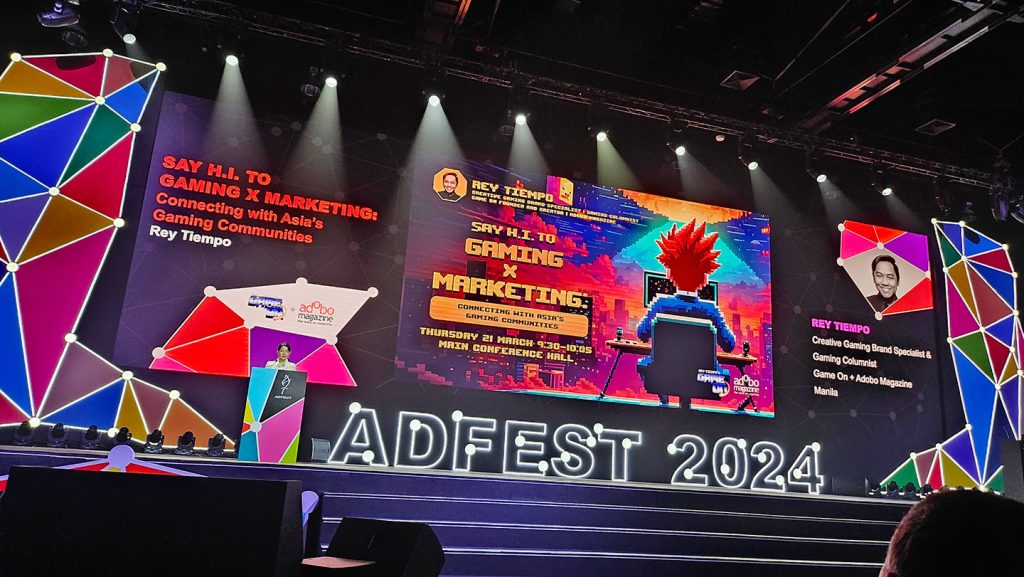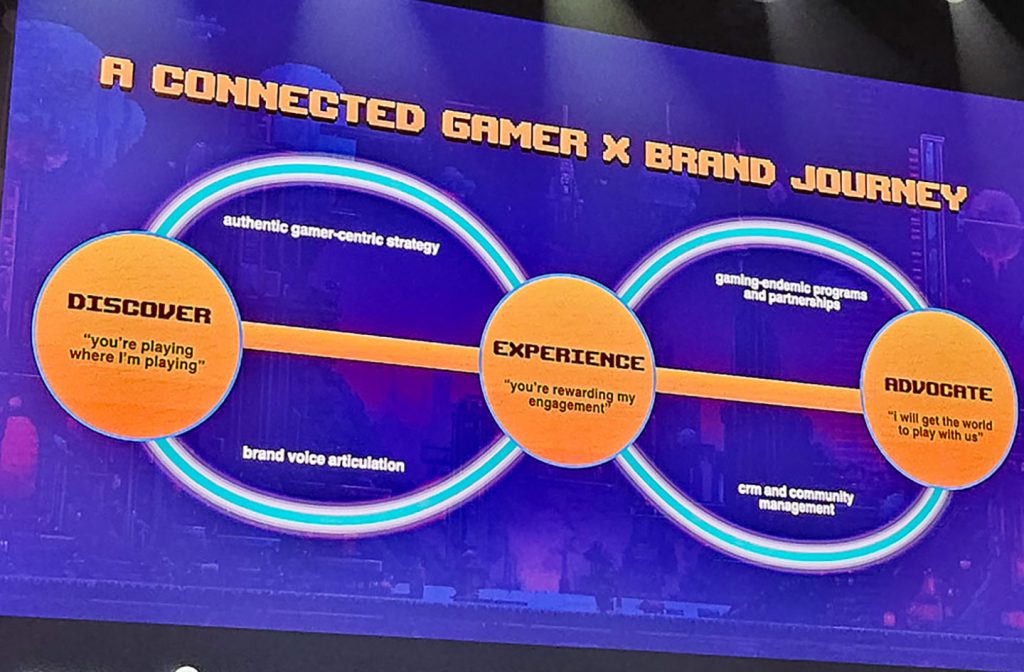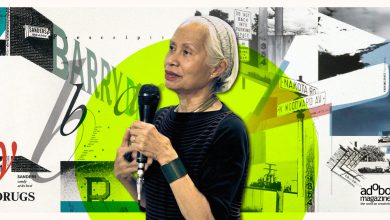PATTAYA, THAILAND — ADFEST 2024, held from March 21 to 23, kicked off with an opening talk by Rey Tiempo, a renowned Creative Gaming Brand Specialist and Gaming Columnist for Game On at adobo Magazine. With over two decades of experience, Rey has spearheaded teams to deliver award-winning projects in major advertising agencies such as Publicis Groupe, VMLY&R, Dentsu, and BBDO. His vast experience in both the gaming and marketing industries provided attendees with valuable insights into the increasingly intertwined worlds of the two fields.
Rey’s talk, titled “Say H.I. to Gaming X Marketing: Connecting with Asia’s gaming communities,” started at exactly 9:30 AM. “It’s never too early to talk about gaming. It’s my passion point,” he said with a wide smile, setting the tone for the session.
“Gamers instinctively want to help each other out. I grew up in the arcade boom of the ’90s, right smack in the middle of that era. I made so many friendships in arcades. There were people from rival schools, but we were all equals there, helping each other out with tips and tricks,” he explained. “That’s why I founded Game On, the first and only industry column/portal of its kind that tackles the intersection of gaming and marketing. It was also to help — but this time, to bridge the gap between the two.”
As gaming emerges as an extremely rich playground and marketing moves into non-traditional spaces, Rey introduced the concept of Gaming X Marketing on the ADFEST stage. He explained that this “fresh new term tackles the ever-increasing relevance and rich creative branding opportunities in gaming.” He further highlighted how this approach addresses the growing relevance of gaming communities, particularly in Asia Pacific.


Rey laid down the facts and figures as to why advertisers should wholeheartedly embrace the gaming hype. “Gaming is bigger than music, linear TV, and film combined,” he said. “Three billion people are gaming right now, at this very moment. When they’re not, they’re watching 25 billion hours of gaming content. When they’re gaming, they’re also actively connecting. No other medium exists this way.”
Rey elaborated on how brands can effectively connect with gaming audiences by debunking three prevalent myths surrounding Gaming X Marketing.
It’s expensive
The first myth he addressed was the notion that Gaming X Marketing is an expensive endeavor. While it’s true that entering the gaming sphere may require an initial investment, it doesn’t necessarily equate to exorbitant costs.
Moreover, Rey emphasized the long-term benefits of investing in Gaming X Marketing. By authentically engaging with gaming communities, brands can cultivate loyal followers and enjoy sustained returns on their investment. “A game can hold your maket’s attention for hours, and then they will talk about it for hours, and then they will keep coming back to it over and over and over,” he said.
Gaming = Gen Z, right?
Rey continued his discourse by addressing the second myth surrounding Gaming X Marketing: the misconception that gaming is primarily associated with Gen Z. He challenged this notion by suggesting that rather than categorizing gamers by age, it’s more pertinent to consider their shared interests and passions. As such, the following interest groups are the largest gamers in Asia Pacific: young adults, moms, foodies, and travelers.
Rey pointed out that while there’s a prevalent stereotype linking gaming predominantly with younger generations, the reality is far more diverse. He highlighted statistics revealing that the median age of gamers is actually around 35 years old, significantly higher than what many might assume. Drawing from his own experience, Rey proudly proclaimed himself as a gamer despite not belonging to the Gen Z.
By debunking the association between gaming and specific age groups, Rey urged brands to adopt a more nuanced understanding of their target audience. He emphasized the importance of recognizing that gamers span various age brackets, each with distinct preferences and behaviors. This insight is crucial for brands aiming to effectively connect with gaming communities and tailor their marketing efforts accordingly.

Gaming is a channel
“Gaming is not one thing,” Rey pointed out as he dispeled the myth that gaming should be treated solely as a channel for marketing purposes. He argued against reducing gaming to merely a distribution platform for advertisements, emphasizing that such a view overlooks the rich and multifaceted nature of gaming.
Instead, Rey advocated for a more holistic approach. He said, “Advertisers must understand: gaming environments are relatively closed-loop systems. Real-world brands risk disrupting this immersive experience, and only the most well-thought-out, authentic brand campaigns will get the most welcome reception.”
By reframing the perspective from gaming as a channel to gaming as a culture, Rey urged brands to engage with gamers on a deeper level. This involves crafting authentic experiences that resonate with gamers’ interests and values, rather than simply bombarding them with advertisements.
Unbranded Menu as case study
After “busting” these myths, Rey proceeded to showcase a case study that exemplified the principles he discussed. This case was none other than the McDonald’s “Unbranded Menu” by Leo Burnett Manila, for which Rey served as Gaming Expert.
The “Unbranded Menu” campaign ingeniously integrated gaming elements into a marketing strategy, challenging conventional approaches and yielding remarkable results. Rey elaborated on how the campaign leveraged gaming as a platform for engagement rather than just a medium for advertisement.
Recognizing the parodies
The success of “Unbranded Menu” can be attributed to its astute recognition of gaming culture and the prevalent use of parodies within it. During his presentation, Rey mentioned how game developers frequently incorporate elements of fast food into their games, often parodying iconic brands like McDonald’s due to their widespread recognition and cultural significance.
In response, the campaign cleverly leveraged this phenomenon by reclaiming the association with McDonald’s in a creative and unconventional manner. Rather than pursuing traditional licensing agreements, which could entail royalties and legal complexities, the campaign opted for a more inventive approach.
By creating the “Unbranded Menu,” McDonald’s and Leo Burnett embraced the existing parodies and transformed them into an engaging gaming experience that resonated with both gamers and fans of the fast-food chain.
Taking it social and influencer
Initially, the campaign was structured around a complicated promotion requiring the use of the McDelivery app. However, Rey recognized the potential to enhance engagement and reach by leveraging the social nature of gaming.
Understanding the mindset of gamers, Rey proposed a shift towards a more accessible and engaging approach: integrating social media into the campaign dynamics. By encouraging players to capture screenshots of McDonald’s “food-alikes” within the game and share them on social media platforms, the campaign tapped into the natural inclination of gamers to share their experiences and achievements online. By offering free McDonald’s food as a reward for participating in this social sharing, “Unbranded Menu” not only incentivized engagement but also leveraged the power of peer influence and social validation to amplify its reach.
The decision to take the campaign social proved instrumental in its success, as it transformed a potentially complex promotion into a fun and accessible experience for gamers. Through influencer partnerships and user-generated content, McDonald’s and Leo Burnett effectively tapped into the vast social networks of gaming enthusiasts, generating widespread buzz and engagement around the brand.

Keep it (stupid) simple
Within jury rooms and industry circles, there’s a consensus that the campaign’s straightforward approach played a pivotal role in its acclaim.
By keeping the mechanics simple and intuitive, McDonald’s and Leo Burnett removed barriers to entry for gamers, making it easy for them to participate and engage. This accessibility was crucial in attracting a wide audience and driving widespread participation in the campaign.
In the context of Gaming X Marketing, brands can break through the clutter and capture the attention of gamers by focusing on simplicity and fun. “Keep the very core of the idea,” Rey shared.
Concluding his talk, Rey emphasized the importance of leveraging existing expertise and strengths in advertising to bridge the gap in Gaming X Marketing. One of the key strengths in this space lies in understanding the unique dynamics of gaming communities and culture.
Gaming enthusiasts are a diverse and passionate audience, and successful marketing in this space requires a deep appreciation for their interests and behaviors. Advertisers must learn to play and game — to immerse themselves in the gaming world, understand its intricacies, and adapt their strategies accordingly.
“The platform is built out of passion,” shared Rey, “and without a display of similar, authentic enthusiasm from brands, the risk of alienation remains high.”
With his mission to educate clients and brands, Rey said that active participation in Gaming X Marketing is his pathway to achieving this goal. Game on.
adobo Magazine is an official media partner of ADFEST 2024.








